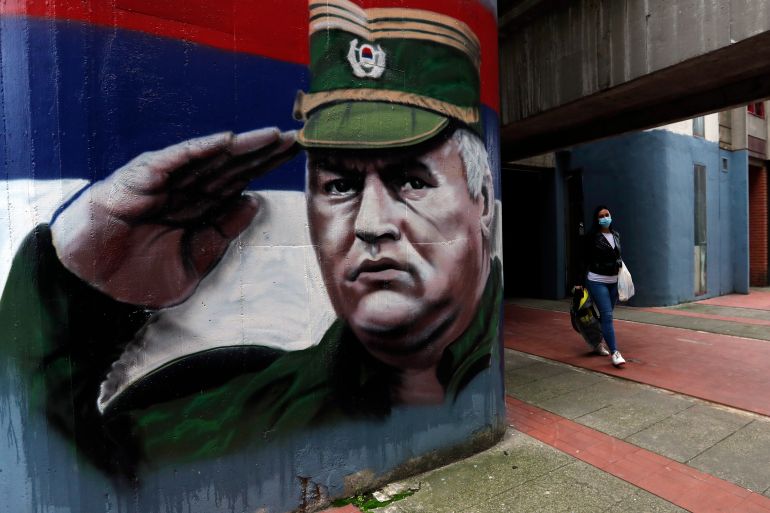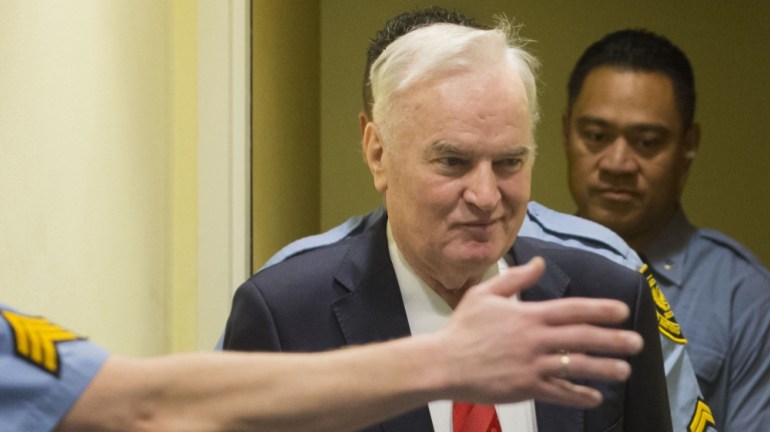In Montenegro, a street was almost named after Ratko Mladic
The proposal was ultimately dropped, but observers say the move was a sign of how Serb Chetniks continue to be glorified, while the Bosniak minority faces growing intimidation.

When a local council in the town of Berane in Montenegro approved a proposal to name a street after convicted war criminal Ratko Mladic, Rahim Muratovic, the local imam, says he was not too surprised.
“It’s to be expected here,” he told Al Jazeera. “We’re used to such things. We live with this in Berane. We always have problems,” Muratovic told Al Jazeera.
Keep reading
list of 4 itemsMontenegro and Serbia expel each other’s ambassadors
Thousands protest new Montenegro gov’t bid to change religion law
Montenegro overturns coup verdict for two Russians, 11 others
The move came earlier this month, when the Serbian monarchist movement reportedly proposed to name a street in Berane after Mladic and the local council in charge of naming settlements, streets and squares adopted the idea, at least in principle.
The proposal was discussed further, but ultimately dropped.
Dragoslav Scekic, president of the municipality, told local media he would not sign off on the proposal as it had no legal basis.
Nevertheless, say observers, that such a proposal had emerged in the first place, and was even considered, is a worrying sign.
Muratovic, the imam, said officials did not condemn the proposal, rather they rejected the idea on technicalities.
In 2017, the International Criminal Tribunal for former Yugoslavia in The Hague convicted Mladic, a Serb general, for genocide, war crimes and crimes against humanity committed in Bosnia and Herzegovina in the early 1990s, and sentenced him to life imprisonment.
Among his crimes, he was found guilty of the genocide in Srebrenica, Bosnia where Serb forces killed more than 8,000 Bosniak men and boys.
Among much of the Serb population, however, Mladic continues to be glorified as a hero along with other leaders who identify with the Serb Chetnik ultranationalist paramilitary movement.
Many Chetniks collaborated with Nazi forces during World War II.
During the war in Bosnia from 1992 to 1995, those who identified with the movement killed non-Serbs (Bosniaks and Croats) with the aim of achieving an “ethnically cleansed” Greater Serbia, which would comprise all of Bosnia.

Muratovic said he occasionally sees provocative graffiti meant to intimidate Bosniak Muslims appear in Berane, and elsewhere in the region.
“Just today I was walking in town and I saw Draza Mihajlovic [Chetnik leader during World War II] drawn on a residential building with ‘Berane is Serbian territory’ written. I saw it today, but it’ll stay there for who knows how long,” Muratovic said.
In late January more graffiti appeared in Berane, threatening the Muslim population with violence, atrocities and genocide.
“Srebrenica” and “Kill [Albanians]” were among the messages written on the building.
Muratovic said this sort of intimidation occasionally appears before and after elections “so we don’t forget who’s boss”.
Local elections are coming up in March in the city of Niksic, 200km west of Berane.
The mosque there was vandalised on Wednesday with red graffiti reading “Niksic will be Srebrenica”, “Turks” – a word which is used as a derogatory slur for Bosniak Muslims – and the 4S Serbian symbol used by nationalists.
In Montenegro, a Bosniak mosque is desecrated with Serb nationalist slogans along side the words “Srebrenica” as well as the derogatory “Turks”. Another attack in a recent wave of incidents against Bosniaks in the country. These deplorable and hateful actions must be condemned. pic.twitter.com/fFUmg74VqJ
— Remembering Srebrenica (@SrebrenicaUK) February 10, 2021
Niksic once had nine mosques but over the years only one has survived – the Hajji Ismail, according to journalist Adel Omeragic.
It survived a bombing in 1993 while a war was being waged in neighbouring Bosnia, when dynamite was placed under the minaret.
In August, ahead of Montenegro’s parliamentary elections, portraits of Chetnik leaders Pavle Djurisic and Mihajlovic were drawn on properties in Berane, in neighbourhoods where Bosniak Muslims live.
Djurisic was a Chetnik leader and war criminal who led massacres of thousands of Bosniak Muslims in the region of Serbia and Montenegro known as Sandzak, as well as in eastern Bosnia.
Ivan Ejup Kostic, a board member of the European Muslim Network who is based in Belgrade, told Al Jazeera the reason behind repeated threats and intimidation of Bosniak Montenegrins lies in the “Greater Serbia” ideology which Serbia never abandoned.
Rather, it has been the dominant political ideal for a century and a half, Kostic said.
The ideology developed a “pathological hatred” towards the “archetypal enemy” – in this case, Muslims, Kostic said.
“In addition to the state of Serbia, the main instigator of the Greater Serbia idea and the unification of ‘Serbian lands’ is the Serbian Orthodox Church [SPC].
“Its main strength lies in the fact that it is guaranteed by law that it can act across borders, which it does.
“Under the guise of the church’s struggle for its religious rights, it conducted political changes which brought to power ultra-right pro-Serbian parties such as the Democratic Front.”
Following elections in August, Montenegro approved a new coalition government in December.
The coalition is supported by the powerful SPC, which seeks closer ties with Serbia.
Back in Berane, Muratovic said locals have been moving away from the region, but especially Muslims, as “they have nothing [here]”.
The 10 percent Bosniak population which lives in the Old Town may dwindle further as a minority.
“People are sending their kids abroad so that they don’t stay here,” Muratovic said. “We always fear that something [bad] will happen.”